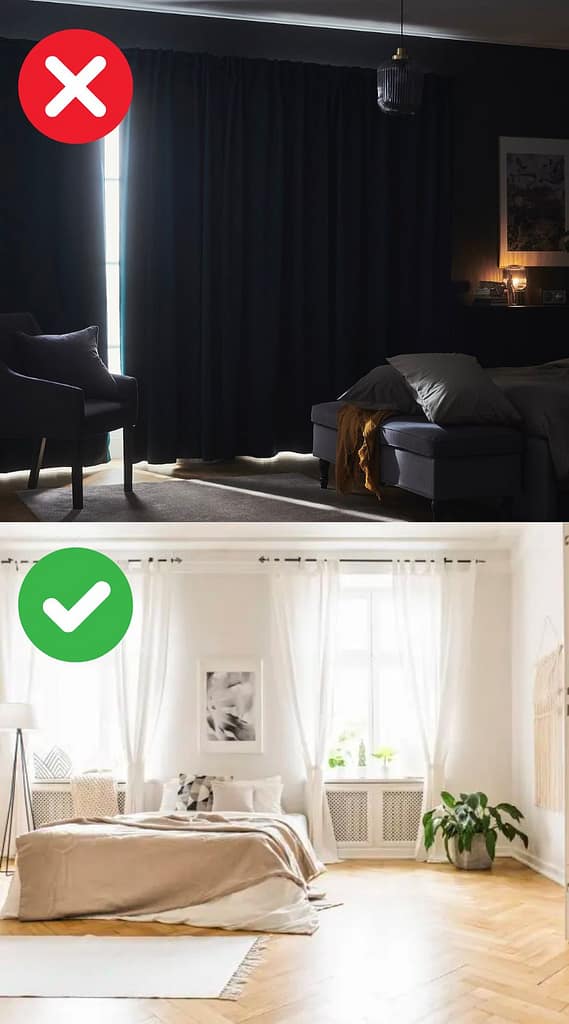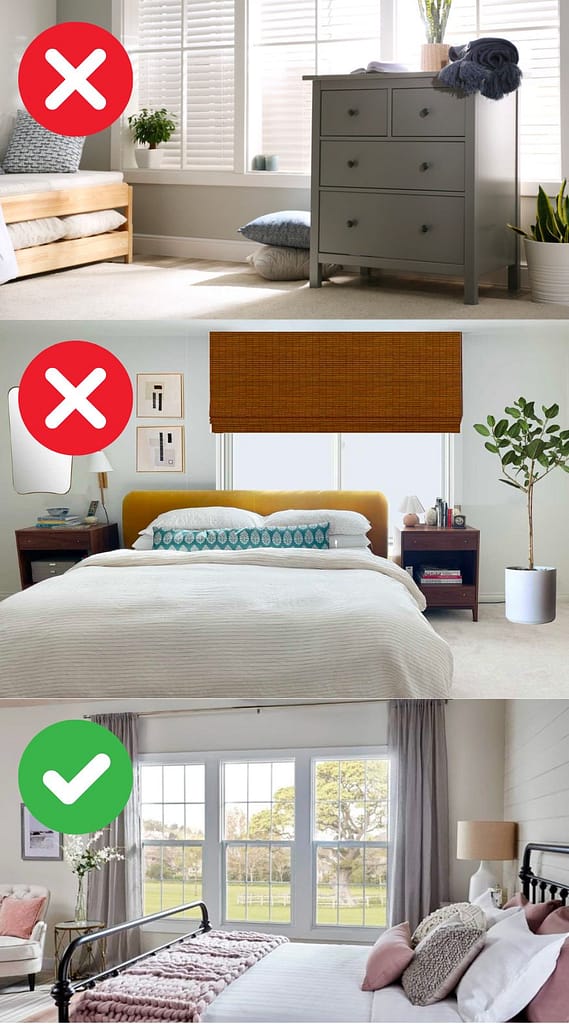I’m glad you clicked on this blog post because it truly is important for you to maximize bedroom natural light. And like always most interior designers pay little to no attention to it.
By letting the sunlight pour into your bedroom, you not only benefit your health but you also benefit your wallet. By using sunlight rather than artificial lights, you will save A LOT of money on your energy bill. Phew, one less financial burden.
If you’ve been following this blog for a while, you would know how much I love saving money myself and helping you save money with me. That’s why I will discuss the best strategies that will bring in more bedroom natural light without requiring you to spend loads of money.

How Do I Add Natural Light To My Bedroom on a Budget?
Yes, it is certainly possible to boost natural lighting in your home on a budget. Most blog posts you’ll see about this topic will simply encourage you to invest in their exclusive window replacement services that will automatically boost the natural lighting for you.
But guess what? Their service costs thousands of dollars. What a shocker.
But don’t worry, with the tips outlined in this article, you can maximize your bedroom natural light without spending money on any expensive services.
And no, I’m not selling you any service of my own, so you can be assured that my advice is purely informational.
How to Increase Bedroom Natural Light
These are some of my best tips to increase bedroom natural light without breaking the bank.
Choose Light-Reflective Colors




Even if your bedroom gets a small amount of natural light, it’s your job to take complete advantage of that.
One of the best ways to do so is choosing light-reflective colors for your bedroom. This can include choosing the right wall paint colors, your furniture color, and the color of any other decor in your room.
You might be wondering, “Well what if I already have dark color furniture in my bedroom?”
In that case, I don’t recommend replacing all your furniture as that’s a waste of money. What you should do instead is use these light colors for decor pieces, such as throw pillows, rugs, or even bedding.
And if you’re really feeling like a painter, why not repaint your walls to a lighter color?
What Are Light-Reflective Colors?
Light-reflective colors are essentially any light or neutral tones or soft hues. These softer shades help create a brighter ambiance as they reflect light rather than absorb it.
Here are some of the most common examples of light-reflective colors that I personally love for any bedroom:
- Off-white
- Pale brown
- Light gray
- Cream
- Beige
Position Your Mirrors Wisely


I’ve seen many interior designers say to “incorporate reflective surfaces.” And I completely agree…for other places in your home.
Because as far as I know, there are very few reflective surfaces options for a bedroom. But there is an alternative to increase the amount of light SIGNIFICANTLY.
The answer is the most reflective thing on earth: mirrors. Mirrors create the illusion of natural light especially for large spaces that have a lot of dark corners.
Step 1 is to place a mirror in the direct path of the sunlight coming into your bedroom. Step 2 is to angle the mirror in such a way so that it reflects the light into dark spaces in your room.
Notice the difference? With just one stream of sunlight, you’re illuminating two parts of your room.
Try this strategy with one mirror first and if you like it, continue doing it as much as you want. It’s completely up to your personal preferences and how much you want to illuminate your dark room.
Selecting the Correct Window Treatments

Whether you have a small window or a large window, it doesn’t matter. I’m here to tell you how to MAXIMIZE bedroom natural light, which means I will help you make the most of whatever you already have.
So without installing new large windows, you can boost the amount of natural light by selecting the correct window treatments. In simple terms, window treatments are anything you put over or around your windows. For example, curtains or window shades.
To bring in more natural light, you MUST abandon your dark curtains and opt for sheer curtains or neutral shades.
These window treatments ensure privacy without blocking out all the natural light like dark curtains do.
Additionally, I always suggest sheer curtains and neutral shades because they also contribute to the overall room feel. When the sun shines on them, they create a warm glow in your room, giving a more cozy bedroom feel.
Don’t Block Your Windows with Bedroom Furniture

This tip seems like a given, but I’ve seen SO MANY people cover part of their window with their desk or bed. To make sure you don’t make the same mistake, I included this tip in this guide.
However, for smaller spaces, it may be really hard to not block your window as you have limited space for all your furniture. Trust me, I experienced the same issue.
But to fix this problem, I rearranged all my bedroom furniture in a way so that I would cover my window as less as possible. For me, the solution was to lean the side of my bed against the window as the height of my bed was lower than the placement of my window.
The solution could vary for you, so I recommend that you just keep experimenting until you find something that works. There are plenty of ways you can arrange your furniture to let in more light.
Regularly Clean Your Windows

While I doubt your windows are completely covered by dirt, even a little bit of grease or fingerprints on your windows can block some rays of sunlight. And the worst part is is that you may not even realize it.
Most window professionals recommend that you clean your windows at least 2 times a year. But you should increase that number if you live in an area with frequent storms. I guarantee that those water drop stains on your windows are blocking a lot of natural light.
That’s why maintaining clean windows is a great way to let extra natural light in. All it takes is a few minutes, a rag, and some Windex!
Trim Any Trees Blocking Your Window

Landscaping and tall trees are beautiful home decor…until they cast dark shadows inside your home. Just to clarify, I’m not talking about indoor plants. I’m talking about trees in your front or backyard that have grown so big that they cover your windows.
While this is most common for living rooms, I’ve seen many bedrooms face the same issue. In fact, my own bedroom window was being blocked by a 7-year old tree growing in my front yard.
It looked beautiful and it was painful trimming it, but it helped A LOT more natural light come in, making my space feel much brighter.
I highly recommend that you do the same if you’re experiencing the same issue. Remember, you do not need to cut down the entire tree. Just a little trimming and you’ll be all set!
How to Make the Most of Any Bedroom Natural Light + Alternatives



Make sure that you effectively use the natural light you are getting. Use as much light as possible without resorting to other light sources.
For example, I highly suggest that you put your desk in an area that receives direct sunlight. That way, you spend the majority of your day living off natural lighting rather than artificial lighting.
Look at the bedroom decor ideas above for reference above. Note how the desks receive direct natural light WITHOUT blocking the window.
However, if you have a significant lack of natural light, then the best solution is to choose energy-efficient light fixtures. Make sure that the light fixtures you choose are affordable and fit your bedroom interior design well.
Conclusion
While artificial lights and light bulbs are great options for bedroom lighting, they don’t give you Vitamin D like natural lighting does.
In my many years of experience with home decor, I have always recommended at least some natural lighting for every spot in your home, whether it’s your bedroom or living room.
Oh yeah, and beware of those blogs selling you window replacement services. Remember, you can easily boost bedroom natural light using these affordable tips outlined above WITHOUT having to invest thousands of dollars in window replacement services.
For other budget home decor ideas and tips, whether it be for your living room, dining room, family room, or kitchen, follow my Pinterest page. I post publish budget home decor ideas every single day for people just like you!
FAQs About Bedroom Natural Light
How much natural light should a bedroom have?
A bedroom should have enough natural light to illuminate your entire room but not so much that your room excessively heats up. Finding the balance between the two can vary from room to room.
It comes down to how big your bedroom is and how powerful the sun rays are. For example, your bedroom will heat up faster with the same amount of natural light in the summer than in the winter. To deal with this versatility, I recommend investing in sheer curtains.
How can I brighten up a room with very less natural light?
To design a room with very less natural light, you should aim for cream or white walls and layered lighting. By including light-colored walls and layered lighting, you will give your bedroom a more natural feel even in a lack of natural light.
It truly is a hack to “fake” natural lighting and make your dark room more lively and brighter.
You should also include dim overhead lighting or table lamps that give your bedroom a warm glow, just like natural lighting does. While it won’t be identical, it will be similar enough for your to get the same room feel.
What is the best lighting for a bedroom?
The best lighting for a bedroom is dimmable overhead lighting because it can completely illuminate a poorly lit room or create a dim aesthetic for you. This makes overhead lights the best budget option that works well for multiple bedroom lighting purposes.
Additionally, with the correct overhead light, you can get pretty close to achieving a bedroom natural light look as well. In my years of experience, what I’ve seen work best in most bedrooms is flush mount ceiling lights as they’re usually dimmable and they also look aesthetic on their own.
Remember, if one light covers multiple bedroom lighting styles, always pick that option. You will save a lot of money.
Meet The Author

Hi! I’m Anish, your budget buying guide! I’ve been reviewing home gadgets and accessories for the past 3 years, so it’s safe to say I know a thing or two about home products.
So why did I start writing these guides? Because I saw that people were spending WAY too much money on home products when there were SO MANY cheaper alternatives out there.
I want to help you save money on your home gadgets without compromising the appearance and functionality of your home. So what better way is there than simply writing about how I do it myself?
I want to show you how you can change the landscape of your home without spending a dime more than what is required. You can save more money than you might think!
6 thoughts on “How to Maximize Bedroom Natural Light: Tips for Real Results”